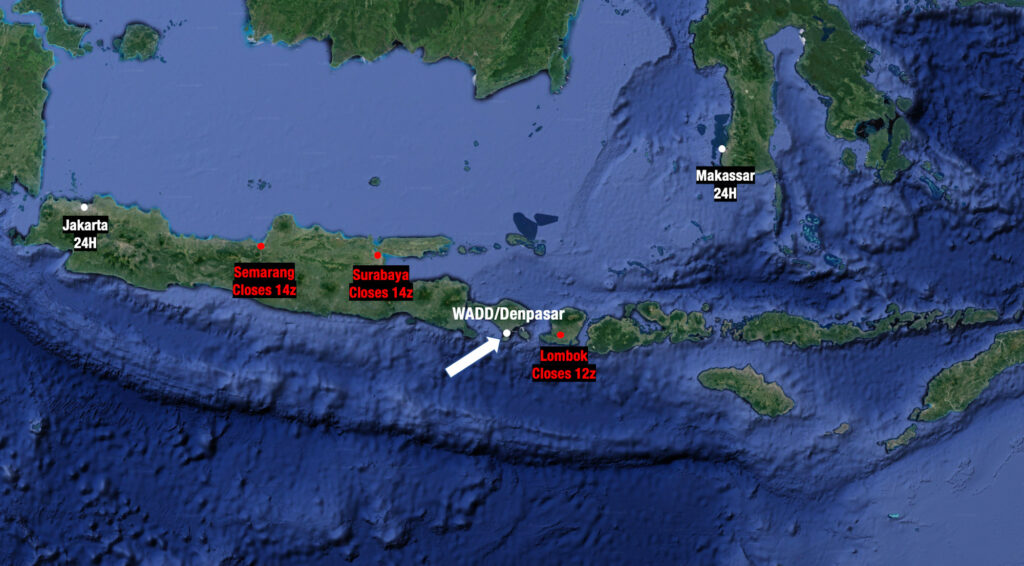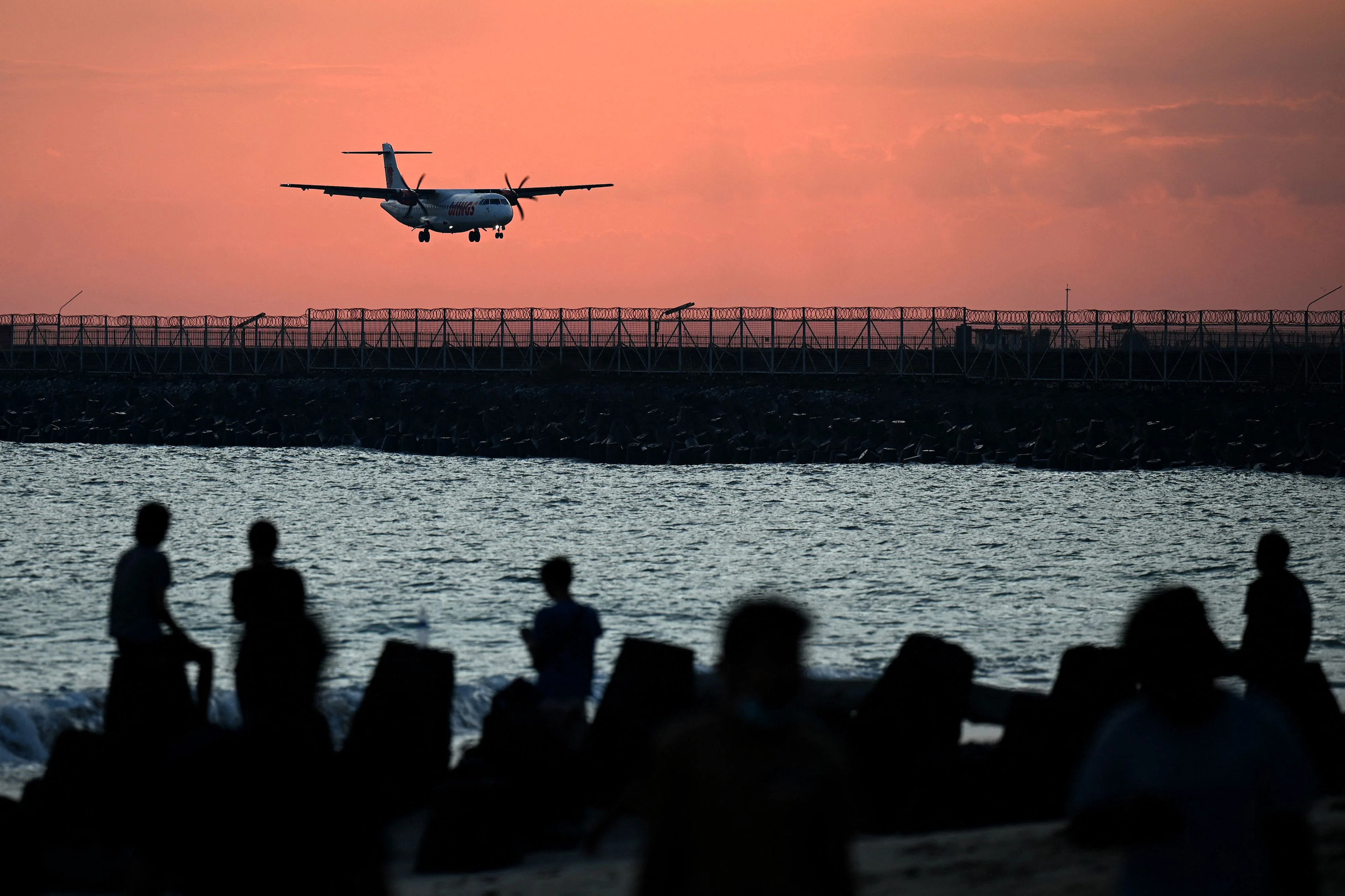If you’re bound for Bali there are a few things you need to know, especially if it is your first time there. Ops there often seem to get disrupted, and you’ll need the option of having someplace else to go. Figuring out where – especially at night – may be harder than you think.
Let’s take a closer look.
At face value, ops at Bali seem straight forward. The runway is long, there is an instrument approach at both ends, SIDs and STARs link everything up and the place is towered 24/7.
But after years of flying in there with a scheduled operator, the number one biggest threat remained fuel in the tanks when it all went pear-shaped – which it sometimes did.
The airport just seems to have a habit of eroding your fuel margins. You may be carrying a healthy alternate enroute, but beware of giving it all away while holding once you arrive.
Delays and short notice closures.
The airport is especially vulnerable to them, and they can be unpredictable. Here’s why.
1. Weather
If you’re flying into Bali during rainy season (November – March), weather is likely to be a major factor. Like clockwork, towering cumulus clouds strengthen throughout the day into powerful thunderstorms in the afternoon and evening.
While the TAF may look identical day in and out, it is luck of the draw whether the airport itself will be affected. And when it is, traffic backs up quickly.

Severe thunderstorms are common in Bali during the wet season.
2. Volcanic Ash
Indonesia rests on the western portion of the Ring of Fire which renders it the third most volcanically active region on earth. There are no less than one hundred and forty-seven volcanoes there, seventy-six of which are currently active.
Eruptions are frequent and occur with little warning causing major disruptions to airports throughout the country – and extensive ash plumes. They can close airports like Bali for days on end, like one did in 2017. And the situation can develop when you’re already airborne.
The closest volcano to WADD/Bali airport is less than 40nm away.
Mount Agung erupted in 2017, closing Bali for several days. Courtesy: IBTimes UK
3. VIP Movements
Yep, someone important is inbound. And guess who has to make way? The airport often gets closed for short periods for VIP movements. You’ll find them in the Notams from time-to-time. Take it from me – apply a healthy buffer to either side as ATC will not necessarily be able to provide you with an accurate time the airport will re-open while you’re racing around that holding pattern.

VIP movements can occasionally close the airport.
4. Traffic Jams
WADD/Denpasar is Indonesia’s second busiest airport second only to Jakarta. Which means it sees a lot of traffic. It also occupies a busy air corridor linking Europe to Oceania. Controllers manage a steady flow of both regional and international traffic from both directions.
It can be difficult to predict the effect of this ahead of time, but it is not unusual to hold inbound on your STAR. And you likely won’t have a head’s up beforehand that it is coming. Extra fuel for traffic holding is absolutely necessary.
5. Congested Frequencies
If you’re getting low on fuel, make a decision early. Don’t wait.
ATC has to manage large pieces of airspace here. On Ujung especially it can be challenging getting heard. Controllers are often managing multiple frequencies – it may seem like you’re being ignored, but you may not be able to hear everyone else talking to controllers over the top of you.
The language barrier can also be an issue – English will likely not be your controller’s first language, and their accents can make them hard to understand. The moral of the story is to be assertive on the radio, and speak slowly and clearly. Try and stick to standard phraseology such as ‘minimum fuel.’ And don’t take a back seat when trying to get an urgent request granted.
But where to go?
If you’re heading into Bali late, you’ll need to pay special attention to alternate planning. All the airports in the region still have special operating hours in place to “avoid the spread of Covid”, as per their notams. At present, WADD/Bali itself is open until 18z (02:00am local) but its closest alternatives are not.
Lombok (WADL/Praya), 85nm. Closed each night from 12z (20:00 local). [Notam B2226/22, valid until Feb 19].
Surabaya (WARR/Juanda) , 160nm. Closed each night from 14z (22:00 local). [Notam A2938/22, valid until Feb 18, actually due to runway closure for works].
Semarang (WAHS/Semarang), 295nm. Closed each night from 12z (20:00 local). [Notam B2231/22, valid until Feb 18].
If it’s late, you’ll need to carry more fuel than usual to reach WAAA/Makassar 320nm away, or WIII/Jakarta 512nm away.

Three of Denpasar’s closest alternates close at night.
And finally – watch out for terrain!
There are some big hills out there. If you’re flying into Bali, there’s a good chance you may yourself under radar vectors at night or in IMC nearby. Protect your aircraft – keep a close eye on where you are relative to that terrain at all times. Especially when it’s busy!
Aircraft arriving from or departing to the northwest need to be particularly wary. Sector MSA just north of the airport rises steeply to 9700’. Further west you’ll find Central and East Java with grid MORAs as high as 14,000’. Also be aware of escape routes if your cabin springs a leak.
More on the topic:
- More: March 2024 Singapore Airspace Changes
- More: Ops in Indonesia: Is it safe?
- More: South East Asia: Open for Business
- More: Aviation in Indonesia: How safe is it?
- More: Indonesia is intercepting aircraft – outside their airspace
More reading:
- Latest: Mexico Customs Surprises: Pills, Vapes, and Laptop Rules
- Latest: Greenland NAT Alternates: Dec 2025 Update
- Latest: Crossing the Quiet South: From Australia to Argentina
- Safe Airspace: Risk Database
- Weekly Ops Bulletin: Subscribe
- Membership plans: Why join OPSGROUP?











 Get the famous weekly
Get the famous weekly 





